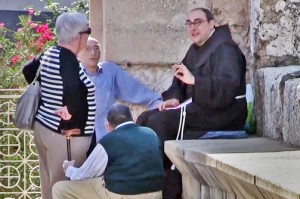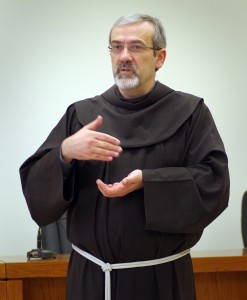Quietly, without drawing attention from their sacred charges, the men in brown robes mingle with tourists and pilgrims alike. For more than seven centuries, the Franciscans, on behalf of Christians of all traditions have kept watch over 50 sites in the Holy Land – 90 percent of the identified Holy places.
“The Christian faith is not just an idea but first and foremost history,” explains Father Pierre Batista Pizzaballa, the head of the Franciscan Custody in the Holy Land. “If there is a history of revelation, then there is a geography of revelation.”
Although the order can date its presence in the area back to 1217, the Franciscans received their charge for overseeing the holy sites in 1342 from Pope Clement VI. The Papal Bull details how the King and Queen of Sicily negotiated with the Sultan of Babylon, who occupied the land at the time, to allow for the “Divine Liturgy” and “Solemn Sung Mass” at the Church of the Holy Sepulchre in Jerusalem. The Pope gave this responsibility to the Franciscans who were already living in the city. As new sites were identified, the Franciscan’s role increased.
But the Roman Catholic Church is not the only Christian entity in the Holy Land nor does it have sole claim to many sites. The Eastern Orthodox and Armenian Orthodox Churches are also highly visible in the Holy Land. The three share a historical presence at the Church of the Holy Sepulchre in Jerusalem and Church of the Nativity in Bethlehem. The arrangements are not without friction. Father Batista noted that few disputes arise from theological issues, but usually around maintenance of the sites which are part of the ongoing exercise of “life together” as they seek resolutions.
Ancient animosities are evident in Jerusalem for example. A dispute over when the Church of the Holy Sepulchre would be open resulted in the keys being held by a Muslim family who would act impartially.
More recently, discussions over much-needed repair to the Church of the Nativity in Bethlehem, which also included the Palestinian Authority, resulted in the church building becoming a World Heritage Site under the umbrella of the United Nations. Currently, repairs to the roof are in progress and other preservation measures are planned.
Of course, few who travel from around the world to visit the sites are aware of the background tensions. What they experience are layers of history – literally. Many of the sites – both sacred and secular –reflect the area’s cycles of conquest, destruction, and rebuilding. It’s easy to see former entrances bricked up, different architectural styles next to each other, and newer walls on old foundations. Ask one of the Franciscan brothers about the history and he will provide all the details.
But the Franciscan presence is not solely focused on preserving and interpreting the past. The order is also concerned about the present and future. One of the challenges of the Holy Land is serving the small Christian minority, mostly Arab, and a growing number of Roman Catholic believers from the Philippines, India and Africa who work in Israel. Franciscans hold Mass, operate schools and support the poor as they do around the world.
They are also aware of the political reality in which they carry out their work and seek supportive relationships with both Israelis and Palestinians.
Interacting with visitors encountering the physical evidence of their faith is the Franciscan’s prime activity in the Holy Land. Father Batista noted a change in the types of visitors they meet. He estimates that 90 percent are what he calls “religious tourists” while the remaining 10 percent are “pilgrims” – people looking for a deep spiritual experience. An increasing number arrive in Israel from Brazil, Russia and Africa.
“It is important for people to come to the Holy Land,” he says. “It will change the way you experience your faith.”
See original story at http://www.catholicregister.org/features/travel/item/16193-holy-land-history-of-the-past-and-in-the-making



